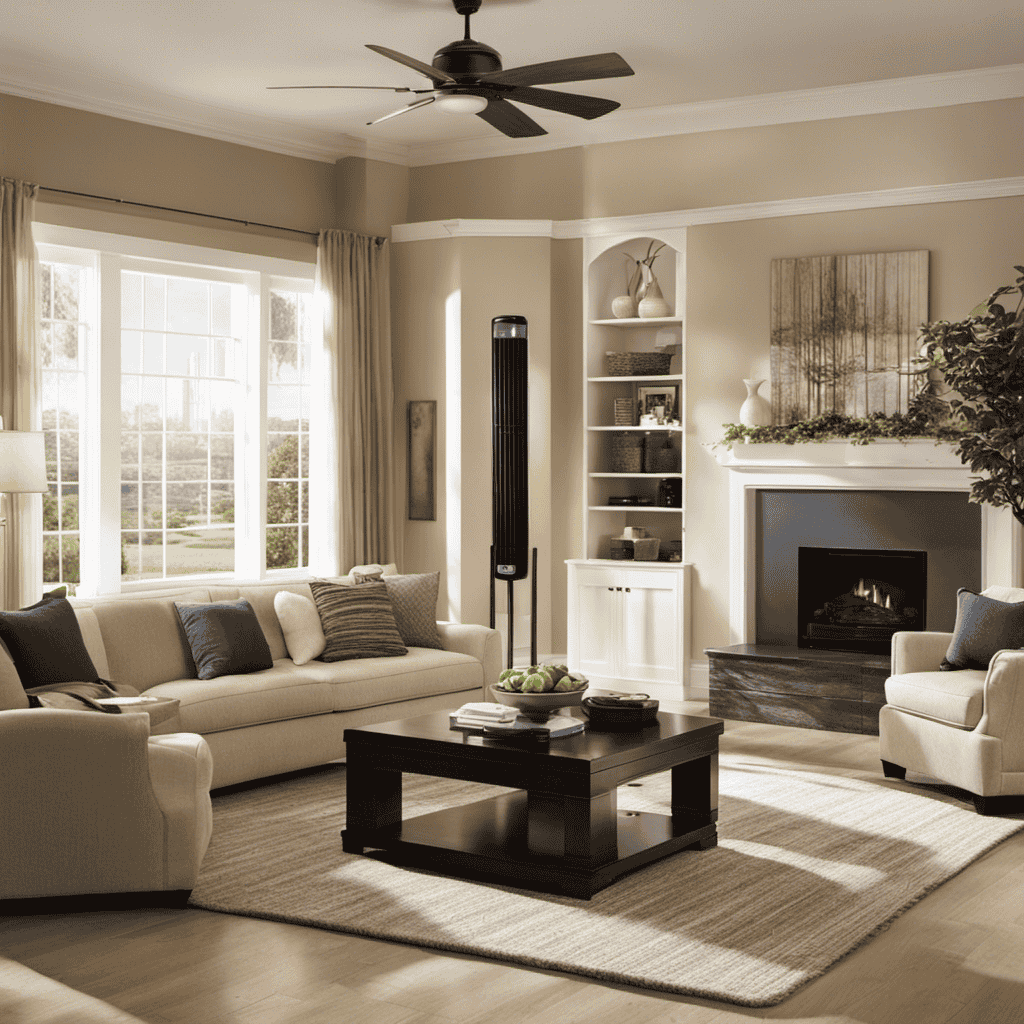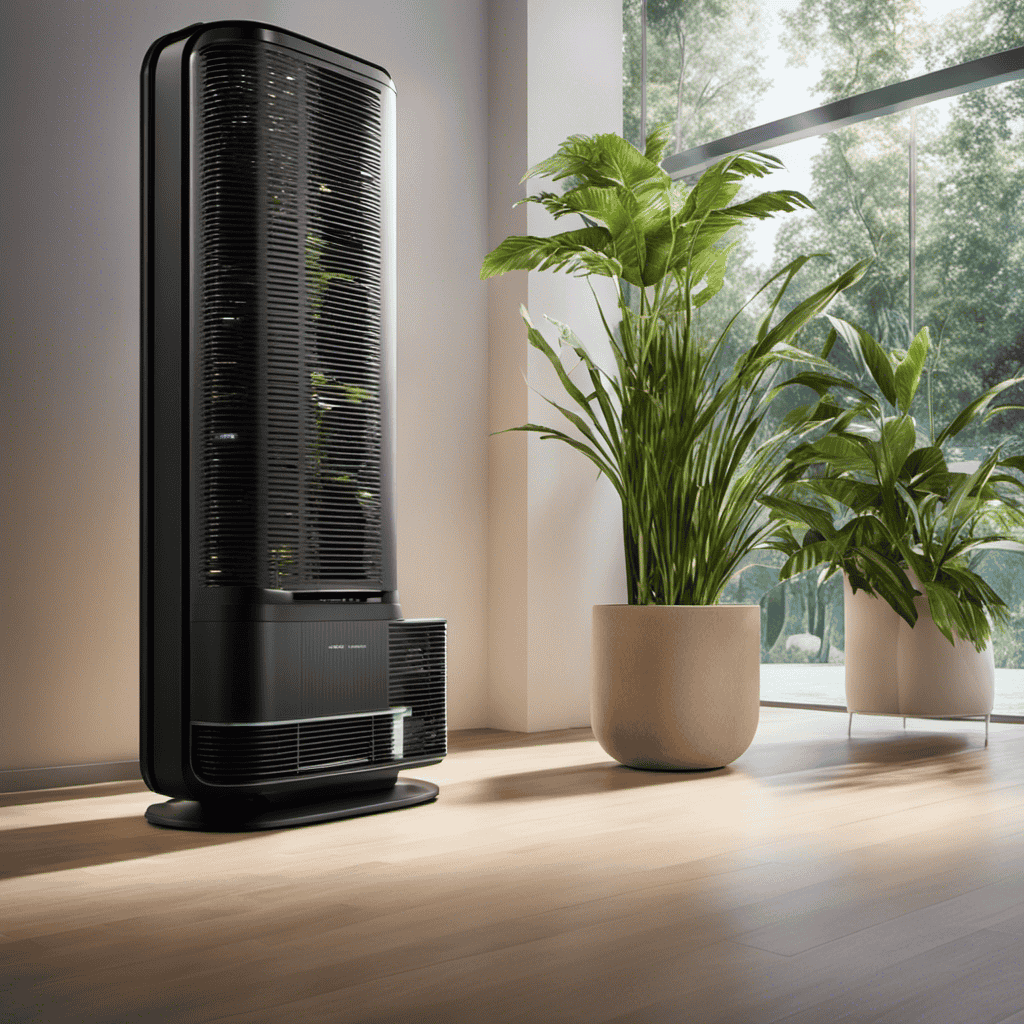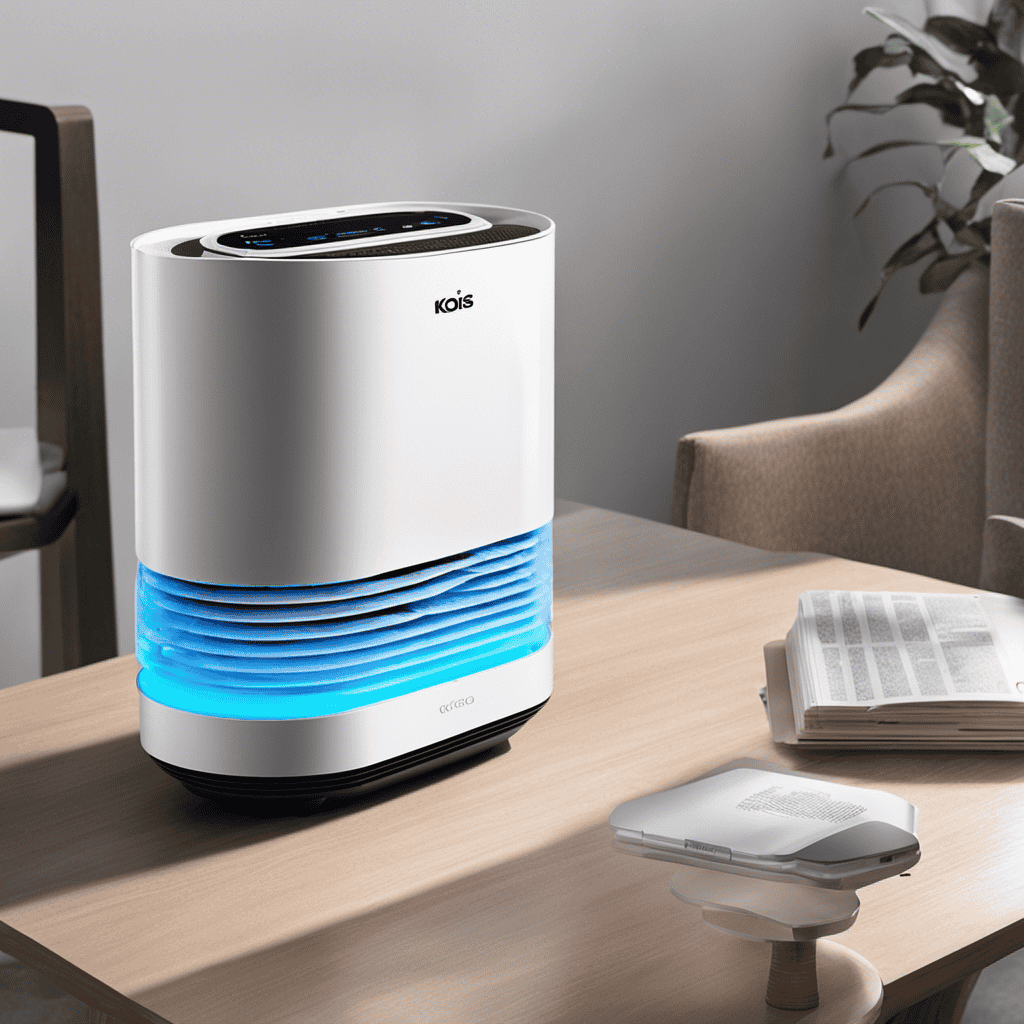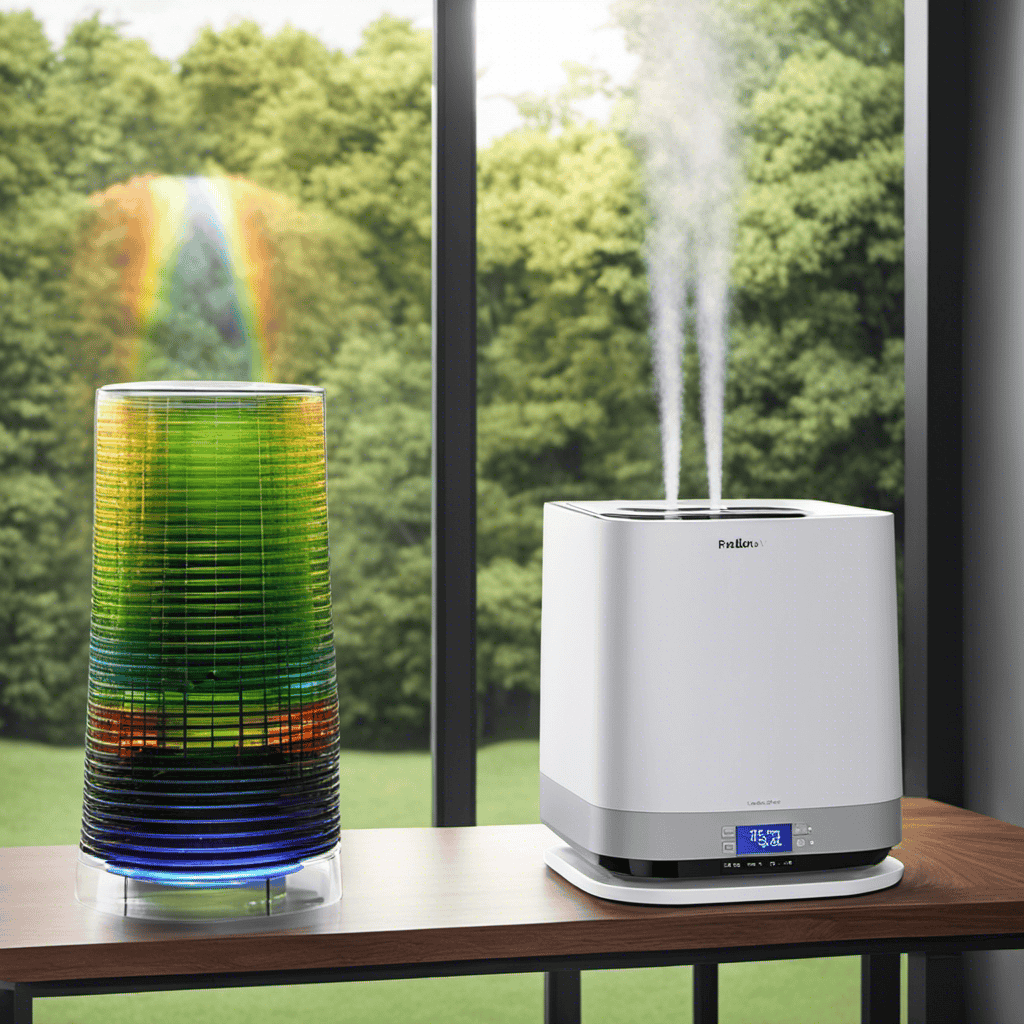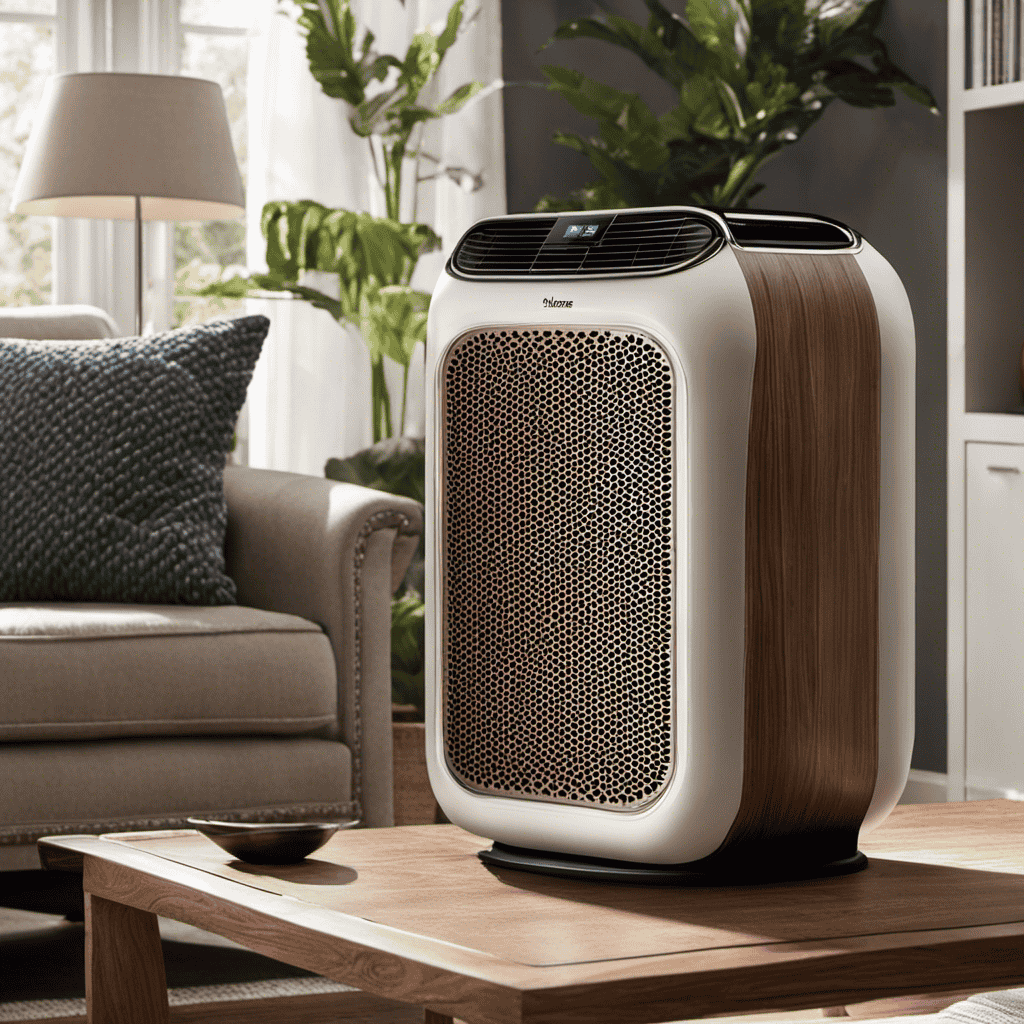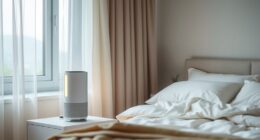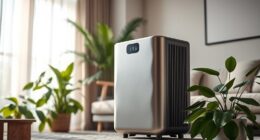Ever pondered what magic air purifiers perform to clean our breathing space? It amazes me how a compact gadget can majorly boost the air we breathe at home.
In this article, we’ll explore the science behind air purification and delve into the filtration process that removes pollutants from the air.
We’ll also take a closer look at the key components of an iconic air purifier and how its fan system plays a crucial role.
Join me as we uncover the advanced technologies that make these purifiers so effective.
Key Takeaways
- Air purifiers use filtration to remove harmful particles from the air.
- HEPA filters trap microscopic particles with an efficiency of 99.97%.
- Activated carbon filters adsorb odors and VOCs.
- The fan system circulates air, allowing it to pass through the filters and purify the air.
The Science Behind Air Purification
The science behind air purification involves removing harmful particles from the air. Indoor pollutants, such as dust, pollen, pet dander, and volatile organic compounds (VOCs), can negatively impact our health.
Air pollution control is crucial for maintaining clean and healthy indoor environments. Air purifiers use various technologies to eliminate these pollutants. One common method is through filtration, where a HEPA (High-Efficiency Particulate Air) filter captures particles as small as 0.3 microns. This filter traps allergens, bacteria, and viruses, improving air quality.
Some air purifiers also employ activated carbon filters to adsorb VOCs and odors. Additionally, technologies like ionization and UV sterilization can further enhance air purification by neutralizing and killing airborne pathogens.
Understanding the science behind air purification helps us make informed decisions in choosing the right air purifier for our needs.
Understanding the Filtration Process
To better understand how an iconic air purifier functions, let’s delve into the filtration process.
The filtration efficiency of an air purifier refers to its ability to remove air pollutants effectively. Air purifiers typically use a combination of filters to achieve this.
The primary filter in most air purifiers is a High-Efficiency Particulate Air (HEPA) filter. This filter is designed to remove particles as small as 0.3 microns with an efficiency of 99.97%. HEPA filters work by trapping airborne particles in their dense fibers.
Additionally, some air purifiers may also include activated carbon filters, which help to remove odors and volatile organic compounds (VOCs) from the air.
Key Components of an Iconic Air Purifier
When it comes to understanding air purifiers, two key components that play a crucial role are the filter technology and the purification process.
The filter technology is responsible for capturing and trapping airborne particles, while the purification process ensures that the air is cleaned and free from contaminants.
In this discussion, we will delve into the specifics of filter technology and the breakdown of the purification process, shedding light on how these components work together to create a cleaner and healthier indoor environment.
Filter Technology Explained
Filter technology in air purifiers works by trapping pollutants and particles in a specialized filter. The filtration mechanism of an air purifier is designed to effectively remove various air pollutants from the surrounding environment. Here are three key aspects of how the filtration process works in an air purifier:
-
Physical Trapping: The specialized filter contains fine pores that physically capture and trap larger particles like dust, pollen, and pet dander. These particles get trapped in the filter’s fibers, preventing them from circulating in the air.
-
Chemical Adsorption: Some air purifiers use activated carbon filters to remove odors and harmful gases. The carbon attracts and adsorbs these substances, effectively reducing their presence in the air.
-
High-Efficiency Particulate Air (HEPA) Filtration: HEPA filters are designed to remove up to 99.97% of airborne particles as small as 0.3 microns. These filters are highly effective at capturing microscopic pollutants like bacteria, viruses, and allergens, improving the overall air quality.
Purification Process Breakdown
To better understand the purification process, you’ll want to know how each filtration mechanism plays a role in trapping and removing different types of air pollutants. The purification process involves multiple stages that work together to ensure clean and healthy air.
First, the pre-filter captures larger particles such as dust and pet dander.
Then, the activated carbon filter absorbs odors, gases, and volatile organic compounds (VOCs).
Finally, the True HEPA filter traps microscopic particles like pollen, mold spores, and bacteria.
In order to maintain optimal performance, regular air purifier maintenance is essential. This includes cleaning or replacing the filters as recommended by the manufacturer. By doing so, you can ensure that your air purifier continues to effectively remove common air pollutants and provide you with clean and fresh air.
Now, let’s dive into how the fan system works and how it contributes to the overall functionality of the air purifier.
How Does the Fan System Work
You’ll notice that the fan system in the air purifier is responsible for circulating the air throughout the room. The fan mechanism plays a crucial role in ensuring that air flows effectively within the purifier. Here’s how it works:
-
Suction: The fan pulls in air from the surrounding environment, drawing it into the purifier.
-
Filtration: As the air is pulled in, it passes through the purifier’s filters. These filters capture particles such as dust, pollen, and pet dander, purifying the air.
-
Output: Once the air has been filtered, the fan then pushes the clean air back out into the room, creating a continuous cycle of air circulation.
The fan’s function is essential for the air purifier to effectively remove pollutants and maintain a clean and healthy environment. Its powerful airflow helps to ensure that all corners of the room are reached, providing optimal air purification.
Exploring Advanced Air Purification Technologies
Using advanced technologies, air purifiers have become more efficient at removing a wide range of pollutants from the surrounding environment. These advanced air purification techniques utilize cutting-edge filtration systems that are designed to capture even the smallest particles, such as dust, pollen, and pet dander.
Additionally, some air purifiers are equipped with activated carbon filters that can effectively eliminate odors and harmful chemicals from the air. Moreover, air quality monitoring is another feature that has been integrated into these advanced air purifiers. This allows users to monitor and control the air quality in real-time, ensuring a healthier and cleaner environment.
With these advancements in air purification technology, individuals can now enjoy the benefits of using an iconic air purifier, which will be discussed in the subsequent section.
Benefits of Using an Iconic Air Purifier
Improved indoor air quality, allergy relief, and prevention are key benefits of using an iconic air purifier. By effectively removing pollutants such as dust, pollen, and pet dander from the air, the purifier helps to create a healthier environment for breathing.
This can greatly reduce allergy symptoms and prevent future allergen exposure, enhancing overall well-being.
Improved Indoor Air Quality
To achieve better indoor air quality, it’s important to understand how an iconic air purifier works. Here are three key components that contribute to its effectiveness in providing health benefits and controlling air pollution:
-
Filtration System: An iconic air purifier is equipped with a high-efficiency particulate air (HEPA) filter that traps particles as small as 0.3 microns. This includes dust, pollen, pet dander, and other airborne allergens.
-
Activated Carbon Filter: The purifier incorporates an activated carbon filter that effectively absorbs and removes odors, chemicals, and volatile organic compounds (VOCs) from the air. This helps create a fresher and cleaner indoor environment.
-
Ionizer: The purifier also features an ionizer that releases negatively charged ions into the air. These ions attach to positively charged particles, causing them to become heavy and fall to the ground, effectively reducing airborne pollutants.
Allergy Relief and Prevention
Understanding the mechanisms of an iconic air purifier helps in preventing and relieving allergies. Allergy symptoms can be triggered by various factors, such as dust mites, pollen, pet dander, and mold spores. These common triggers can cause sneezing, coughing, itchy eyes, and congestion.
An iconic air purifier uses a combination of filters and technologies to remove these allergens from the air. Firstly, a pre-filter captures larger particles like dust and pet hair. Then, a HEPA filter traps smaller particles, such as pollen and mold spores. Additionally, some air purifiers incorporate activated carbon filters to eliminate odors and chemicals. Finally, advanced purification technologies like UV-C light or ionizers can neutralize bacteria and viruses.
Frequently Asked Questions
How Much Electricity Does an Iconic Air Purifier Consume?
An iconic air purifier consumes a moderate amount of electricity due to its energy-efficient design. Its advanced filtration system and smart sensors optimize performance while minimizing power usage, making it an environmentally-friendly choice for clean air.
Can an Iconic Air Purifier Eliminate Odors From the Air?
Yes, an iconic air purifier can eliminate odors from the air. It utilizes advanced filtration technology to remove particles and pollutants, including pet odors and smoke smells, leaving the air fresh and clean.
Is an Iconic Air Purifier Suitable for People With Respiratory Conditions Like Asthma or Allergies?
An iconic air purifier is suitable for people with respiratory conditions like asthma or allergies. Its effectiveness in removing pollutants from the air can provide relief. Regular maintenance ensures optimal performance of the purifier.
Does an Iconic Air Purifier Produce Any Ozone or Harmful Byproducts?
No, the iconic air purifier does not produce any ozone or harmful byproducts. It uses advanced technology to filter and purify the air, ensuring a clean and healthy environment without any negative side effects.
Can an Iconic Air Purifier Be Used in Large Spaces Like Open-Plan Offices or Living Rooms?
Yes, an iconic air purifier can be used in large spaces like open-plan offices or living rooms. It is designed to effectively clean the air in such areas, removing pollutants and improving overall air quality.
Conclusion
In conclusion, the iconic air purifier is an impressive device that effectively improves indoor air quality. With its advanced filtration process, it efficiently removes harmful particles such as dust, pollen, and pet dander.
The fan system plays a crucial role in circulating the air and ensuring thorough purification. Additionally, this innovative technology has been shown to reduce indoor air pollution by up to 99.97%, according to recent studies.
Investing in an iconic air purifier is a wise choice for anyone seeking cleaner and healthier air in their homes or workplaces.

